How Buck McKeon created a global drone enterprise
- Published
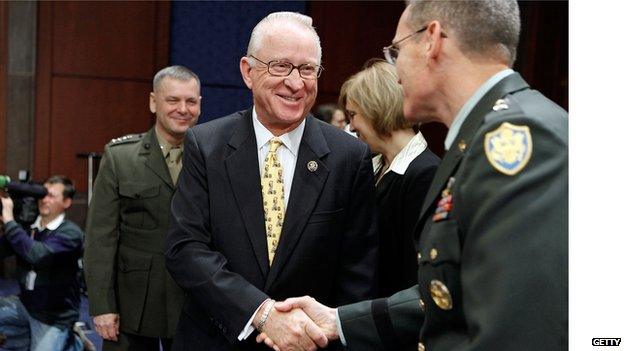
Congressman Howard "Buck" McKeon is described as "affable and well-respected" - and as a fierce champion of the drone manufacturers in his California constituency
A lawmaker helped create the drone industry - and has reaped the benefits.
A drone reportedly flew over North Dakota last year, taking pictures of a meth lab. The drone's flight log, external was released in July in response to a lawsuit filed by the Electronic Frontier Foundation, a civil-liberties organisation.
The flight log sheds light on the way drones are being used - routinely and to an extent not previously known to the public. The release of the flight log and other documents caused a furore, and civil libertarians expressed dismay over the widespread use of drones.
However surprising the news about the drones may have been to activists, the surveillance of the meth lab is part of a global trend. Officials in Northern Ireland used drones to keep dignitaries safe at the G8 summit in June. Drones have flown over train tracks in Germany to look for graffiti artists.
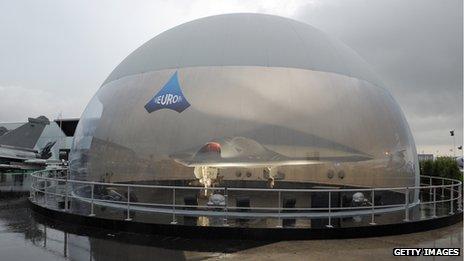
Drones were on display at the Paris Air Show earlier this summer
Many countries, including China and Israel, make drones. Yet the US is the world's leader in creating technology for drones and in promoting their use - for both military and civilian purposes. The interest in drones in the US crosses political lines, with both Democrats and Republicans investing in the aircraft.
President Barack Obama, a Democrat and a liberal, has been more aggressive than his predecessor. US forces have launched about 360 drone strikes against al-Qaeda commanders and other militants since 2009, according to the New America Foundation, external. That is more than six times the number of strikes that President George W Bush authorised during his two terms.
The increase in the use of drones came partly because technology improved over the years, making the strikes more efficient, and also because Obama adopted a more focused campaign against al-Qaeda commanders and other militants in Pakistan.
The US-directed strikes, which are deeply unpopular in Pakistan, are frequently in the news - an attack reportedly killed six in Pakistan earlier this week. US Secretary of State John Kerry said recently the US would end the drone strikes, however, "as we have eliminated most of the threat".
Less well known, however, is the fact that drones are used in the civilian airspace over the US, UK and Europe.
It is a growing, if under-reported, trend. Many of the drones used in Pakistan, along with those sent to Afghanistan, now have a permanent home in the US. These drones are turned over to civilians who work for the federal Customs and Border Protection agency, police departments, and other government offices.
The story of how drones became a robust niche in domestic law enforcement - and part of the commercial world as well - is rooted in Washington DC. Indeed, the rise of the drone can be traced in part to one man, Howard "Buck" McKeon.
McKeon, a California Republican, is chairman of the House armed services committee and co-chairman of a legislative group he founded, the Congressional Unmanned Systems Caucus, external, which supports expansion of the industry.
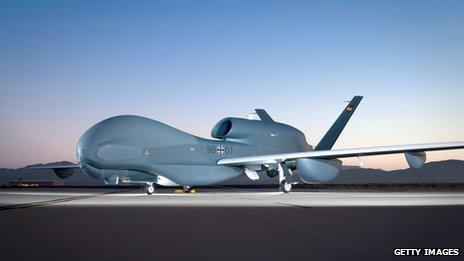
A Euro Hawk, parked in the Mojave Desert, is one of the newer models
Military officers on Capitol Hill and executives in the aerospace industry have welcomed McKeon's support.
Of the dozens of members on the Congressional Unmanned Systems Caucus in the House of Representatives, McKeon has received the most "drone-related campaign contributions" - $833,650 (£551,689), according to a report, external by Hearst Newspapers and the Center for Responsive Politics.
McKeon is a case study in how a member of Congress can work within the system, operate within ethical boundaries created by Congress, and have an impact on policy - as well as increase profits for Boeing, Northrop Grumman and Lockheed Martin, all of which make drones in his district.
McKeon, who has not been accused of any crimes or charged with any ethical violations, refused repeated requests for interviews for this article.
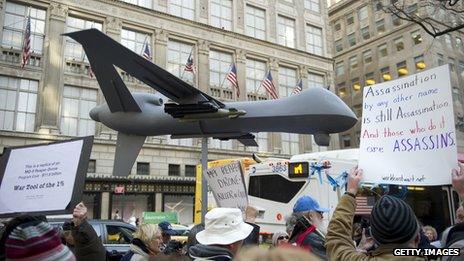
New Yorkers march against the use of drones
Years ago, Americans were shocked at the way lobbyist Jack Abramoff worked the system in Washington. But he was also convicted of bilking, or cheating, Indian tribes, and imprisoned for serious criminal offences.
After the scandal, members of Congress re-examined their ethical rules. Today, however, the system remains much the same.
Lobbyists promote clients, including the makers of drones, and contractors give money to members of Congress, who in turn work on legislation that regulates their industry. Within this world of money and politics, McKeon is one who stands out.
Not only is McKeon the recipient of contributions from drone manufacturers, but he is also one of Washington's most vocal supporters of the industry. He and members of his Capitol Hill office have close ties with lobbyists and contractors.
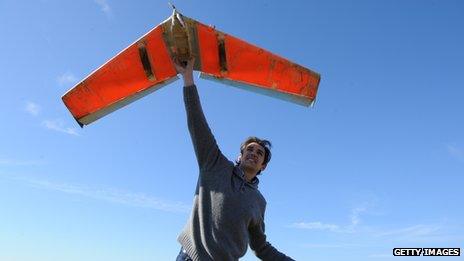
Small drones such as this French model help farmers take care of their crops
In a "Most Corrupt" report for 2012, external compiled by researchers for Citizens for Responsibility and Ethics in Washington, a progressive watchdog group, McKeon is one of several given a "dishonourable mention" over a mortgage he had received on preferential terms and his alleged improper use of official staff.
Another Citizens for Responsibility and Ethics in Washington report, external looks at the way members of Congress "use their positions to benefit themselves and their families".
The report says McKeon's campaign paid his wife, the treasurer, a salary of about $118,000 (£77,956) in the 2010 campaign cycle.
McKeon once received a cut-rate loan from lender Countrywide Financial, as researchers for Citizens for Responsibility and Ethics in Washington point out. He was included in a congressional report, external about Countrywide's attempt to influence members of Congress.

A member of the Mexican navy tries out a new drone
McKeon has not been accused of wrongdoing. A spokesman for McKeon told a New York Times reporter that McKeon was "shocked and angry'' to hear his loan was mentioned in the investigation.
One morning in February, McKeon walked down a marbled hallway on his way to a hearing in the Rayburn House Office Building and made a bow toward uniformed men standing near a doorway. The cordial relations are hardly surprising. He is "the defense sector's top congressional ally", according to Defense News.
"Gentlemen, you have no stronger advocate than the members of this committee," McKeon said during a hearing on the federal budget.
Gordon Adams, a former director at the Office of Management and Budget in the Clinton administration, says drones will remain "a high priority" for the Pentagon.
"The applications of unmanned systems are virtually limitless," McKeon said in a press release.
Meanwhile, drones are flying around Washington in military exercises, another sign that drones are increasingly part of the landscape in the US.
Matt Scassero, executive director of the Mid-Atlantic Unmanned Aerial Systems Coalition and formerly vice-commander of the Naval Air Warfare Center Aircraft Division, has watched one fly above the Patuxent River in Maryland.
"Quietly," he says.
Drones are restricted to specifically designated airspace such as the one in Maryland, where military personnel fly drones for training purposes. Police officers and border patrol agents can also fly them.
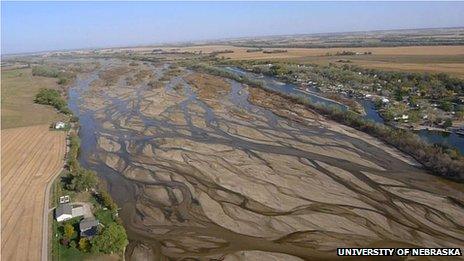
A university professor used a drone last year to photograph a Nebraska drought
Drones cannot be used for commercial pursuits, though that is likely to change. At the behest of Congress, Federal Aviation Administration officials are looking at ways to introduce drones into the civilian airspace. Officials expect that 10,000 drones will be flying in the air by 2020.
The presence of drones above cities and towns has troubled lawmakers. Virginia was the first state to enact a drone ban. Idaho and Florida have since followed suit.
State legislatures in Tennessee and Montana have passed anti-drone legislation. Lawmakers are worried drones will spy on people, especially since their sensors "scoop up quite a lot of information", according to the Brookings Institution, external.
In addition, drones are plagued with flaws. One may have been hacked, according to media accounts, external. Another crashed recently near Panama City, Florida.

Drones used by US soldiers in Afghanistan will soon be coming home
Matt Waite, the founder of the Drone Journalism Lab at the University of Nebraska-Lincoln, says he understands the concerns lawmakers and others have about drones. Yet he believes their benefits outweigh the danger.
Drones have been used to help rescue a child. A 65-year-old man, Jimmy Lee Dykes, held a boy hostage in an Alabama bunker earlier this year while police and a drone kept watch.
"It looked like our Puma," says Steve Gitlin, an AeroVironment spokesman, referring to one of their smaller models. The boy was rescued.
Drones make it easier for biologists to study wildlife and for journalists to write about floods and other natural disasters.
"If a reporter is on the scene with a UAV," Waite says, using an acronym for unmanned aerial vehicle, "he can send it a few hundred feet in the air, take a few photos and put them on the internet."
Filmmakers abroad used drones during the production of the James Bond movie Skyfall and Smurfs 2. Moviemakers have started to campaign for the use of drones in the US, where laws still prohibit them in commercial enterprises.
"Drones are safer and much less expensive than manned helicopters," says Kate Bedingfield, a Motion Picture Association of America spokeswoman. "They allow for creative, dynamic shots without putting anyone at risk."
McKeon and other members of the Congressional Unmanned Systems Caucus reportedly helped push through a law, the Federal Aviation Administration (FAA) Modernization and Reform Act, in February 2012.
It sets policies for the civilian use of drones by 2015 and is designed to make things easier for journalists, filmmakers, biologists and others who want to use the drones in their daily work.
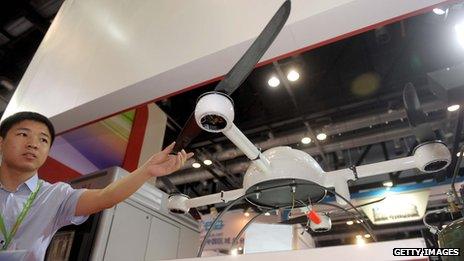
Some of the surveillance drones are made in China
The new law makes individuals such as the Project on Government Oversight's Winslow Wheeler uneasy. He says that McKeon and his colleagues in the congressional caucus are acting more as boosters of drones, rather than as critical observers of the industry.
When McKeon was a child in California, his parents sold meat out of a second-hand fish truck. Later they opened Howard and Phil's Western Wear, and he worked for the family business. He went to Brigham Young University in his 40s and majored in animal husbandry.
From his early days in Congress, McKeon was recognised as someone who worked hard for business owners. Jane Harman, a former member of Congress, introduced him at a 1993 event as "someone who helps me save the aerospace industry in California".
Over the years McKeon has travelled to Northrop Grumman's facility in Palmdale, California, and to other drone manufacturers in his district.
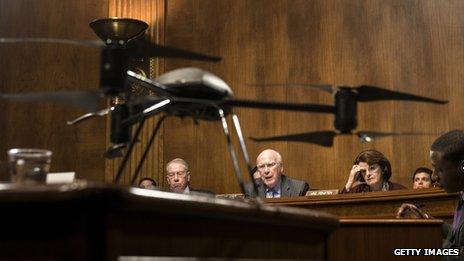
US senators discuss drones during a hearing in March
In 2001 McKeon made the rounds at a trade fair near the US Capitol. He admired the Pegasus, which was made by Northrop Grumman, and told Helicopter News he was impressed with its "cost-effectiveness".
An executive with a company called Textron, which makes unmanned systems, started giving campaign money to McKeon that year. The following year, according to Aerospace Daily, McKeon began asking heads of the military services to issue a report about plans for unmanned aerial vehicles.
McKeon continued over the next decade to push for federal money for drones and travelled to Turkey, Kuwait and elsewhere, speaking with officials about the unmanned aircraft.
McKeon is "the staunchest advocate for military power", says Thomas Donnelly, a director at the American Enterprise Institute, adding that McKeon has a "gentlemanly" manner.
"Not the kind of guy you'd see on cable news, throwing spit balls at the opposition," says Donnelly.
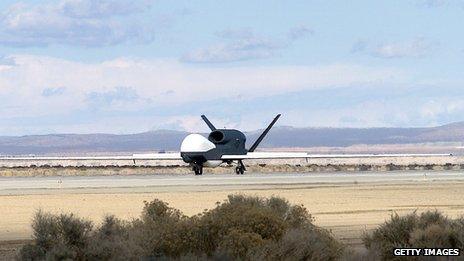
A Global Hawk, shown in 2003, that was made in Palmdale, California
"Very affable and well-respected," says Mackenzie Eaglen, a research fellow at the Heritage Foundation, a conservative think tank, in Washington DC.
But Wheeler provocatively counters that McKeon's judgment is coloured by a lack of knowledge. "He reads off the material his staff has prepared," says Wheeler. "He has been spectacularly clueless in looking seriously at drones."
Critics say lines between government and industry are blurred. Executives at one company, AAI Unmanned Aircraft Systems, were involved in the formation of the Congressional Unmanned Systems Caucus.
"We were original plank holders in the UAV caucus," says AAI Senior Vice-President Steven Reid. Many of the defence contractors belong to the Arlington, Virginia-based Association for Unmanned Vehicle Systems International.
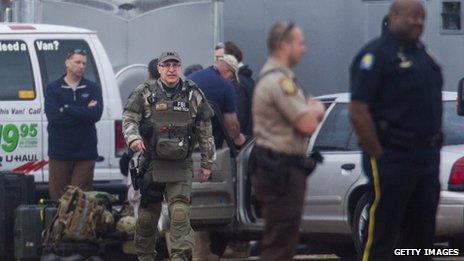
A drone was used for surveillance during a police stand-off with a hostage taker
The Congressional Unmanned Systems Caucus posts photos of the Association for Unmanned Vehicle Systems International's (AUVSI) posters on their website and echoes their language in press releases.
In July 2012 Michael Toscano, president of the group, said: "Unmanned aircraft extend human potential." Days later the caucus issued a press release about drones, describing their "potential to save time, money and lives by extending the human reach".
In addition, people who work for the advocacy group are said to have written a section of the 2012 FAA legislation, which speeds up the process for drones to be integrated into civilian air space.
"The industry was kind of bragging about it," says Amie Stepanovich, a litigation counsel for the Electronic Privacy Information Center.
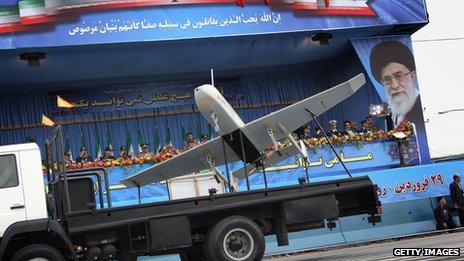
An Iranian drone was put on display in Tehran in 2010
According to a slide presentation created for a 2011 event in North Dakota, Toscano referred to sections of the bill that look at unmanned aerial systems:
"The only changes made to the UAS" - an acronym that refers to unmanned aerial systems - "sections of the House FAA bill were made at the request of AUVSI. Our suggestions were often taken word-for-word."
Ben Gielow, government relations manager for the Association for Unmanned Vehicle Systems International, said later that members of the association did not write the bill.

Smurfs 2 was made with the help of a drone
"We're not members of Congress," Gielow says. "We don't necessarily get anything passed into law." Still, he says they were involved: "As the industry advocacy group, we made suggestions, and our suggestions were incorporated into the bill."
Sarah Binder, a senior fellow at the Brookings Institution, says: "The question is will it pass the sniff test of how we think policy should be made?
"An average person would wonder, 'Are these decisions that would be made in the absence of lobbying by the defence industry?'"
Gary Bass, founder of OMB Watch, which later became known as Center for Effective Government (he is no longer with the organisation), says: "You make sure money gets to the key contractors in your district.
"In the case of drones, the question - 'Is this the smartest thing?' - may be secondary."
McKeon is one of the figures who are behind the growth of the drone industry, and money is given to him for that reason. With backing from the industry, he has become influential in Washington and in this way is better able to help them obtain funding for drones.
"He is propelling business as usual," says Wheeler, "an apparatchik in a broken system".
Tara McKelvey researched this article under the auspices of American University's Investigative Reporting Workshop, external.